Tagged with 'Gems'


The very latest news, musings and opinions from the world of Winterson. Quite simply, a celebration of a jewellery, fashion, culture and the business behind luxury.
-
What is my Birthstone?
What is my Birthstone?
Birthstones are enduringly popular when choosing and giving jewellery. The gemstones that are aligned with particular months of the year now also appear more frequently in all types of jewellery, particularly in those types that sit close to the body such as rings, pendants and earrings. In this article we look at their history and how to identify 'what is my birthstone'?
Finding Your Birthstone
There are a number of different versions of the birthstone guide. At Winterson we draw from the British National Association of Goldsmiths list, created in 1937, with some of the more contemporary American additions, from the later 20th century.

To discover your individual birthstone, our Gemstone Guide is full of information on individual types of gems, as well as explaining their unique characteristics, composition and heritage.
The History of the Birthstone
The concept of the birthstone, or the notion that certain gems associated with months of the year can have positive benefits, is believed to have started with the first century historian Josephus.
Josephus attributed mythological importance to the twelve stones embedded in the breastplate of Moses’ brother Aaron. The number, he believed, signified the tribes of Israel, the twelve months of the year, and the twelve signs of the zodiac. The breastplate was believed to have held emerald, sapphire, diamond, topaz, carbuncle, sardius, agate, amethyst, onyx, jasper, beryl and ligure (argued by some to have been a form of amber, and by others, lapis).
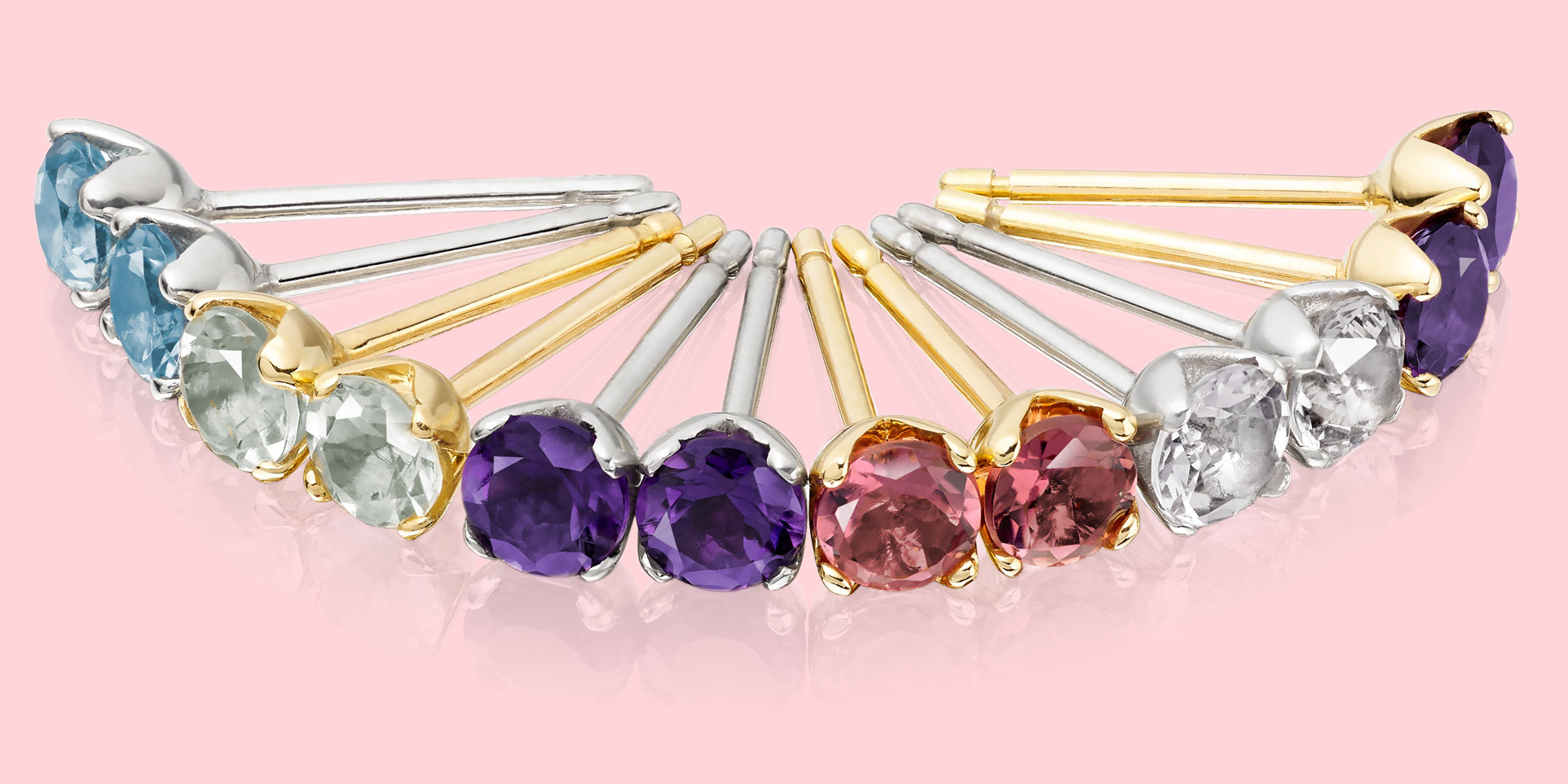
Image: Gemstone stud earrings, Lief collection at Winterson
Josephus suggested that people should own all 12 birthstones and wear each gem in its corresponding month. This concept has similarities to the Eastern navratna, or nine stones, which many Hindus believe combine to protect individuals from harmful influences and support the wearer through life’s challenges.
The contemporary Birthstone is born
Renowned gemologist George Kunz believed that the modern variation of the birthstone concept that we follow today was established in 18th century Poland. Gem traders were thought to have used the idea of the birthstone as a form of early marketing, although the Gemological Institute of America locates the birth of this practice in 1560s Germany.
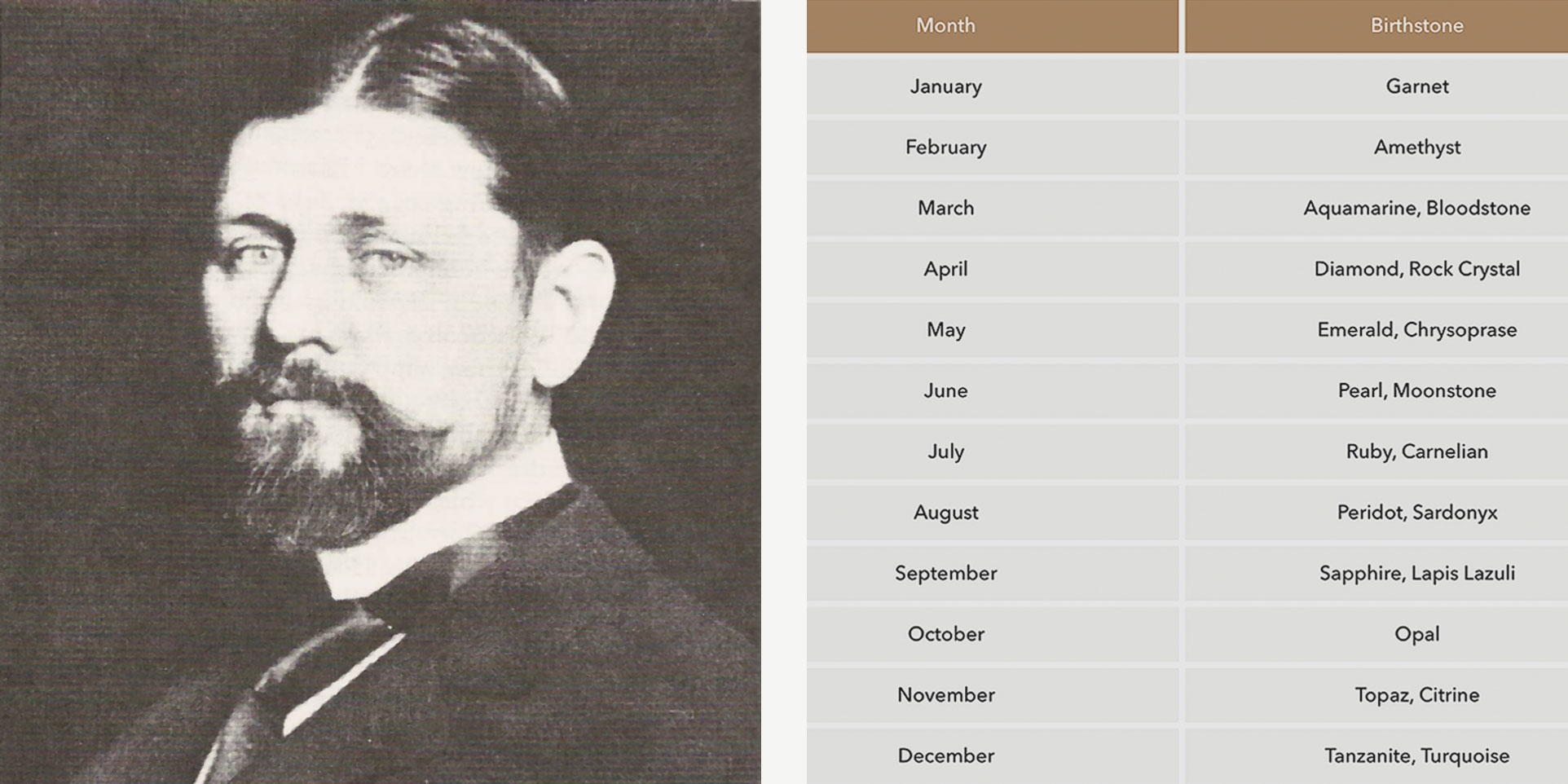
Image 1: George Frederick Kunz, gemologist, circa 1900
Image 2: Table of UK birthstones, Winterson birthstones by month
The concept, Kunz believed, was aimed at increasing sales of a wider range of stones, broadening the choice for consumers and at the same time opening up a new avenue for increased sales of the jewels that contain them.
Defining the list of Birthstones
In 1912 the American National Association of Jewelers gave the practice a formal grounding, producing a list of twelve birthstones that has largely remained the standard ever since.
Additions were been made in 1952, when the Jewelry Industry Council of America made Alexandrite another gemstone for June. Pink tourmaline was added for October, citrine for November, and lapis replaced zircon as the birthstone for December. More recently, Tanzanite was added to December’s birthstones by the American Gem Trade Association, which also added spinel to August in 2016.
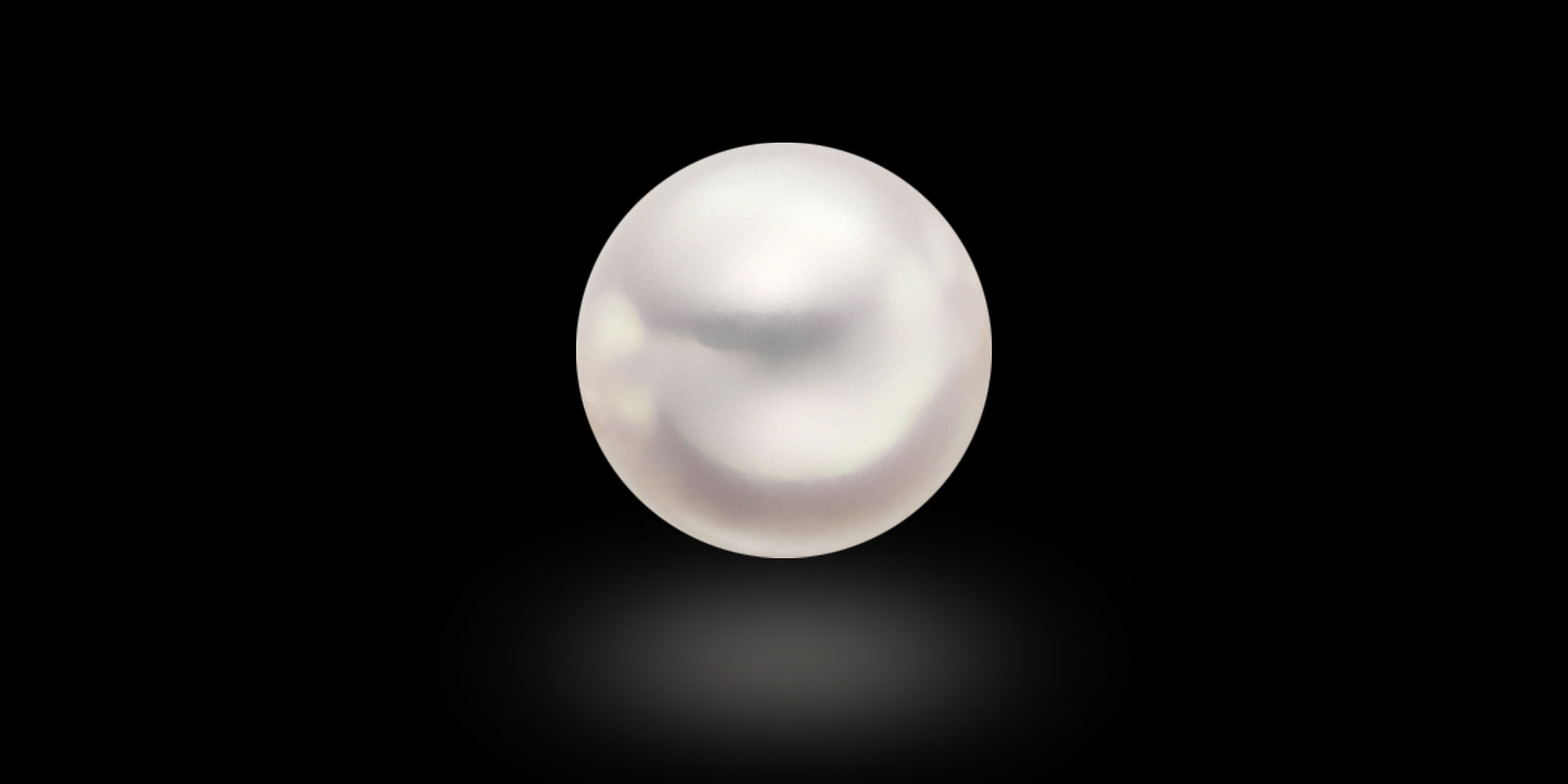
Image: The iconic pearl
The British National Association of Goldsmiths created its own list in 1937, drawing largely on the 1912 version, and this forms the foundation of our own Buying Guide to Birthstones, which features a table that outlines the relationship between birth months and their specific gems.
The Birthstone for June
For Winterson, June is one of our favorite months! The beginning of summer, it is also the traditional birthstone month of the pearl.

Image 1: Classic Akoya Pearl Necklace and Earrings Set in White Gold
Image 2: Mythologie Akoya Pearl and Diamond Pendant in Rose Gold
The pearl is also considered lucky for the astrological signs Cancer and Gemini. The pearl is associated with loyalty, love and generosity, as well as innocence. Many Eastern cultures also believe the pearl can help to counter anger and increase creativity. -
Introducing the new Mythologie collection
Introducing the new Mythologie collection
Introducing the Mythologie collection, inspired by the myths and legends of the fabled pearl. The wonderful shape of the pearl, and its associations with water, has reached across many cultures and celebrated as a symbol of purity, love and wisdom.
This legend of the drop shaped pearl is the basis of our inspiration for Mythologie. Aphrodite, Goddess of Love, was born from the sea, and the Greeks believed that pearls were created from the drops of water that cascaded from her body as she rose from the ocean. Hindu folklore also speaks of pearls as dewdrops that have tumbled out of the night, into the moonlit sea. Shafts of light from the moon drew oysters to the surface of the water, glistening with heavenly dew.

Image 1: Classic Leverbacks with Mythologie Amethyst Drops in White Gold
Image 2: Mythologie Akoya Pearl and Diamond Pendant in White Gold
Chinese legends suggest that pearls were the thoughts formed inside the mind of the dragon, and brought into the world as the drops of mist of the dragon’s breath. Arabian myths suggest pearls are hardened moon drops. The ancient Japanese believed they were created from the tears of fantastical creatures, such as mermaids, nymphs, and angels.
The collection features earrings and pendants created from amethyst, green amethyst, rose quartz, London blue topaz, aquamarine and citrine – and of course the pearl – all complemented with a delicate pave of diamonds, like drops of dew.

Image 1: Mythologie Akoya Pearl and Diamond Pendant in Yellow Gold
Image 2: Classic Leverbacks with Mythologie London Blue Topaz Drops in Yellow Gold
The Mythologie earring drops have also been specially created as a complement to our classic Diamond Leverbacks. The leverbacks are already a versatile addition to any jewellery wardrobe, with a range of interchangeable pearls in Akoya, freshwater drops, Tahitian pearls in tones of grey, black and peacock, and stunning golden and white South Sea pearls. The new Mythologie drops extends this flexibility further, with colour or tone, whatever your outfit.
For the Mythologie collection, we are also introducing a new blue diamond leverback earring in white gold, and a pink diamond leverback in yellow gold. These two new earrings offer a dramatic complement to the new gemstone drops, creating a stunning way to change the style of your jewellery.
Image 1: Classic Leverbacks with Mythologie Rose Quartz Drops in Rose Gold
Image 2: Mythologie Green Amethyst and Diamond Pendant in Rose Gold
To match the leverback fittings, the Mythologie pendants are available in the same gemstone combinations and are suspended below a special drop-shaped white diamond pendant, finished in 18 carat white gold.
The pearl’s long association with love is captured in the fable of Krishna, the Hindu god of love, who dived to the bottom of the ocean to capture the finest pearl drop to give as a gift on the marriage of his daughter. In the Ramayana, the elements of earth, fire, air and water offer up gifts to the gods; the sea offers the pearl, and the gods wear them next to their hearts.
Give the gift of love with a piece of jewellery from Mythologie collection. -
The New Precious Gems
The New Precious Gems
How are precious gems defined by today's jewellers and how has this changed over the years? Precious and semi-precious gems have become more difficult to define and distinguish from each other. At the same time more and more extraordinary, but less well-known stones have been added to the fine jeweller’s palette.
In this article we look at some of the key qualities of precious gems and how we look at these in our approach to jewellery design.
Early classification of precious gems
Traditional systems of gemological classification date back to the ancient Greeks when a young philosopher, Theophrastus, began to define the material composition of stones, based on their behavior when heated. His work called On Stones was the first exploration of gemstones to move beyond the ancient mythological fables, magical or talismanic properties that had been associated with them in the past.
Theophrastus was amongst the first to attribute preciousness to a limited number of gemstones. Although the term semi-precious was only coined later in the Victorian era, On Stones established the idea that particular gems were precious due to a set of natural qualities such as colour, clarity and carat weight. It remained a key text for jewelers throughout the Renaissance.
The Cardinal stones
Emerald, ruby, sapphire, diamond and amethyst were known as the Cardinal stones, a core group of gems that symbolised the power and wealth of the church and aristocracy.
Amethyst in particular was marked out as a regal stone; Queen Elizabeth I banned all commoners from wearing purple, including amethyst, the rarity and cost of the dye echoed in the rarity and the cost of the gem.

Image 1: A pair of Lief Earrings in Yellow Gold with Green Beryl and Tahitian Pearls
Image 2: A pair of Lief Earrings with Pink Tourmaline and Akoya Pearls
The distinction of preciousness reflected not only the scarcity of these stones in ancient times, but their material quality. All of the Cardinal gemstones are translucent with fine colour in their purest forms, even the diamond whose purity is judged on its lack of subtle colour. These gems are also very hard materials, registering 8 to 10 on the Mohs hardness scale.
Questioning precious
The established definition of precious does not necessarily encompass all ancient beliefs though. Pearl, opal and amber were equally revered as precious gems, and handcarved stones (emeralds, rubies, spinels and banded agates) were the height of perceived authority and craftsmanship. Great value was also placed on visual beauty, mythic and healing properties.
Nor does the traditional definition of precious reflect the contemporary value of gems. For example, while some garnets are relatively inexpensive, the tsavorite garnet can be far more costly than a mid-quality emerald.
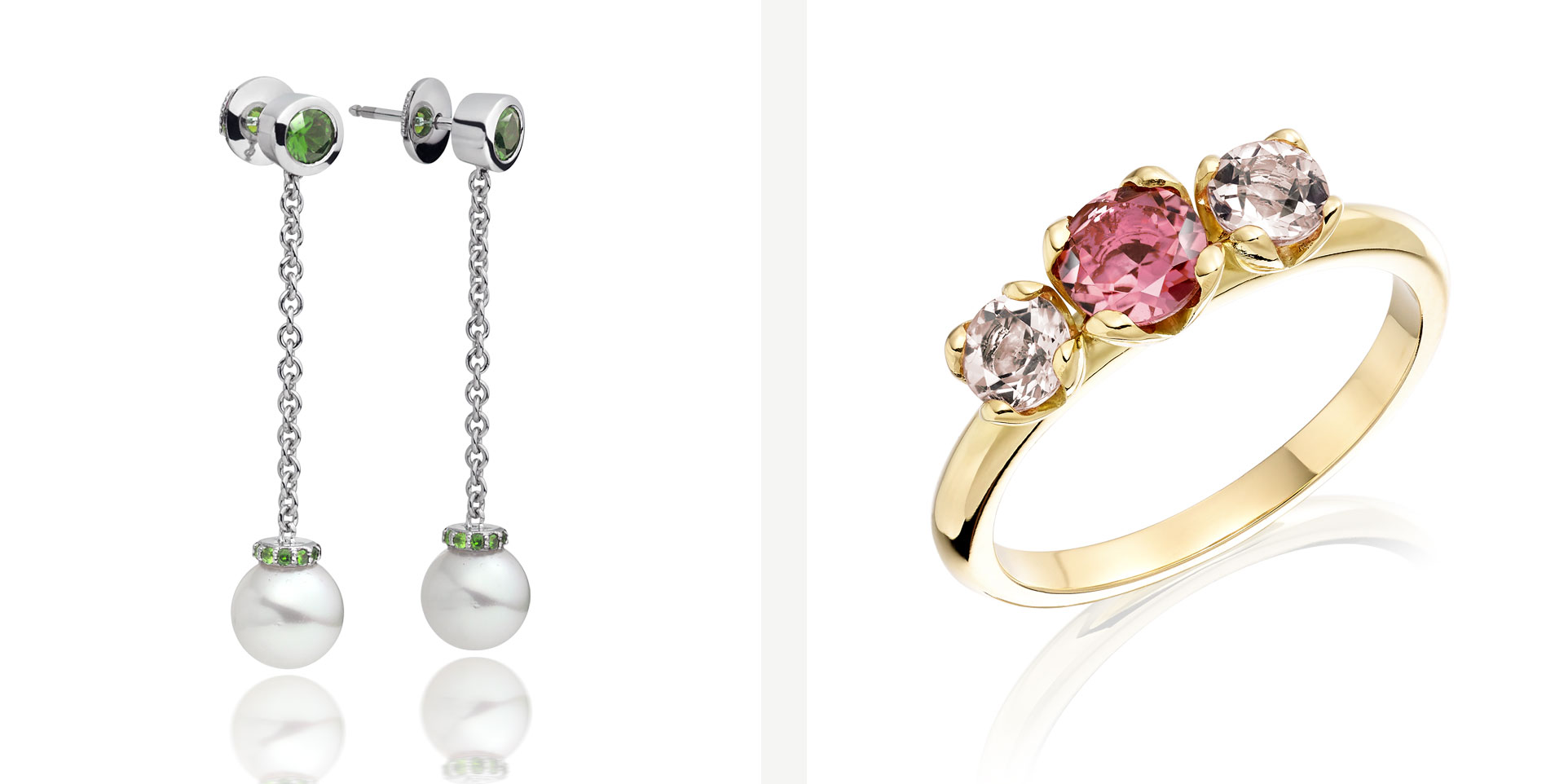
Image 1: A pair of Tsavorite Garnet and Akoya Pearl Drop Earrings with 18ct Gold
Image 2: Lief Ring with Pink Tourmaline and Morganite
If preciousness is a quality of rarity, there are a number of coloured gems that might also lay claim to the description. Gemstones such as the paraiba tourmaline and tanzanite are found in only one location, and in limited, finite quantities.
Beryls such as morganite, aquamarine, helidor and green beryl, all of which share the mineral composition of emerald, and imperial topaz with its natural peach and orange tones are highly prized especially when they are found with strong depths of colour. Bold coloured stones such as mandarin garnet, tourmaline and even peridot are increasingly difficult to source in their most potent shades.
A new definition of Precious
At Winterson, we look for gems that have strong colour, whose tones complement the overtones and orient of our fine quality pearls.
We also highly prize a gem’s intrinsic natural beauty. Like many gemologists today, we perceive the value in each stone and each pearl based on their unique individual qualities - the new definition of preciousness. -
Bejewelled Treasures from the Al Thani Collection
Bejewelled Treasures from the Al Thani Collection
Winterson's Creative Director Alice Cicolini takes a retrospective glance at the celebrated Al Thani collection of jewellery. The exhibition, which first appeared in Bejewelled Treasures at London's Victoria & Albert Museum, is set to open this Spring at the Grand Palais, Paris in March 2017.
The Al Thani Collection is a unique collection of jewels from an unusually broad chronological period that spans the Mughal period of the early 1600s to the present day. With such a diverse group of objects to select from, the V&A exhibition's curator Susan Stronge paints an impressive, if partial, picture of the development of Indian jewellery techniques and tastes.
Jewellery in Mughal society
The focus in the early part of the exhibition emphasises the almost ubiquitous presence of gemstones and jewellery throughout the Mughal court: from fly whisks and wine cups, to backscratchers and huqqa bases. The prevalence of precious and semi-precious gems led visitors to India in this period to remark on the magnificence of courtly life, its gem-encrusted thrones and imperial bodies that sparkled with jewels.
Hindu rulers lived under clear instruction as to the importance of establishing of an almost God-like regal body politic, through dress, jewellery and grooming. This remarkable profusion of jewellery, which their Mughal successors appeared to share, went far beyond the ruling classes to encompass men and women at all levels of society.

Image 1: Spinel and pearl necklace
Image 2: Silk sword sash with jewelled gold fittings
This is very revealing of the important role that jewellery played, not simply in the creation of status, but in what modern historian Daud Ali has described as “the spiritual and literary life of Indian societies” and the “association of jewels with light, virtue and beauty”. It is in early Sanskrit texts such as the arthashastra and brihatsamhita that the spiritual, cultural and healing values of stones, grading & assessment and jewellery techniques began to be established.
A love for pearls and gems
Many of these central tenets of gemlore still inform contemporary Indian jewellery making and buying practice, today with the navratna, or nine-stones, continuing to play a alismanic role in jewellery culture. Of these, the five great stones, or mahararatnani, - diamond, pearl, ruby, sapphire and emerald - dominate Indian jewellery culture as they did several hundred years ago.
As a result, for pearl lovers the Bejewelled Treasure exhibition offers a wealth of extremely fine examples. Visitors to India frequently remarked on the ropes of pearls that covered the bodies of both men and women, rulers and lesser subjects alike, upon which it would have been difficult to place a price. The arthashastra particularly notes methods for grading pearls, and the types of necklaces into which they could be strung, including one gravity-defying necklace of 1,008 rows.
It may be that one of the reasons that visitors saw pearls worn by non-royal courtiers was that, much like their British equivalents, Indian rulers charged their servants with wearing their pearls during the day to keep them both warm and luminous. Although the geographical proximity to the pearl fishers of the Arabian Gulf and Sri Lanka would have given Indian rulers greater access to pearls than some of their European peers, the pearl was still regarded a symbol of status. Some rulers were believed to drink powdered pearls as an aphrodisiac, and the Sanskrit word for pearl, manjari, means “bud” denoting the sensuality the gem has come to symbolise.

Image 1: Diamond turban jewel made for the Maharaja of Nawanagar
Image 2: Cartier Brooch set with emeralds, sapphires and diamonds
Other notable aspects of the exhibition include several exquisite examples of spinel, a stone which has long been celebrated in the subcontinent whilst remaining relatively unknown in the West. A combination of increasing scarcity, the price of tourmaline, the prevalence in the market of glass-filled and heat treated ruby and the spinel’s relatively low profile, however, marks this gemstone out as a major jewellery trend.
One of the main centerpieces of the show, and one of the few pieces in the exhibition not from the Al Thani Collection, is the Timur Ruby, rather abstractly titled since it is neither a ruby nor was it ever owned by the famous Indian ruler. Now part of the collection of Queen Elizabeth II, the stone was given to Queen Victoria by the East India Company in 1851, and then set in gold, enamel and diamonds by Garrards in 1853. The gem itself demonstrates the significant value placed on these stones by a succession of Mughal rulers, engraved as it is with the names of five royal owners from Jahangir, son of Akbar, in 1612 to Sultan Nadir in 1741.
Contrasting traditional with modern
The Timur Ruby also demonstrates the differing understanding of value that remains central to much of India’s more traditional jewellery making practice. Unlike Western cultures, where brilliance, fire and perfect precision cutting constitute extraordinary gems, the Indian subcontinent holds true (in its more traditional manifestation) to the notion that a stone’s natural character and form – its scale, luminance, colour and clarity – are what defines its beauty.
One of the main techniques that the exhibition focuses on is kundan, the practice of using highly refined gold to set natural, irregular stone shapes within fine, symmetric settings. Its aesthetic is one that has come to define traditional Indian jewellery, and its abandonment by India’s contemporary high jewellers is one of the most notable characteristics of their perceived modernity.
It is the quite clear break with traditional jewellery making practice that the exhibition makes visible, which is one of the show’s most interesting features. Alongside the rejection of traditional setting techniques, it is the widespread preference for platinum (with yellow gold removed to the reverse or interior structure of these new jewels) that has seemed to define “modernity” in contemporary Indian jewellery.
Western influences
Certainly this trend is most evident within the fertile Art Deco period that saw such a volume of commissions from Indian rulers to luxury high jewellery houses in the West such as Cartier, Boucheron, and more recently JAR, and more recently in contemporary jewellery from India itself.

Image: Gold and diamond hair ornament
Stronge implies that the increased cross-fertilisation with Western tastes has resulted in a loss of regional difference across Indian jewellery, although it's perhaps difficult to conclude about a wider trend from the prism of a very personal selection of objects. It is certainly true that the contemporary jewelers that Al Thani has favoured lean very heavily towards the language of Westernised Indian-ness that Cartier, his Indian clients, and the many other 1920s Western jewellery houses who operated in the country, helped to establish.
The exhibition catalogue relates a lovely vignette of Jacques Cartier’s first visit to India as part of the Delhi Durbar of 1911, marking the coronation of George V as Emperor of India. Cartier had brought, Stronge relates, a selection of jewellery for women, but rapidly realized “the enormous potential of this market was that the princes bought mostly for themselves”.
The legacy of the Al Thani treasures
Perhaps what makes this exhibition so unique in its presentations of high jewellery is that the majority of the pieces chosen have been created to be worn or used by men rather than women, and this in itself is something worth visiting for.
As masculine jewellery cultures diminish so dramatically across the world, the exhibition profiles a dying way of life – both that of the makers, as their traditional arts appear to fade from fashion, and the wearers, and ways of wearing, that these extraordinary gems represent. -
Meet the Colourful New Additions to the Lief collection
Meet the Colourful New Additions to the Lief collection
Following the success of the enchanting Lief earrings, designed by Winterson’s Creative Director Alice Cicolini, a series of irresistible gemstone rings and pendants are now joining the collection.
Hand-crafted in the UK and finished to perfection in 18 carat gold, the six new striking pieces continue the theme of colourful gemstones and the wild leaves of Winterson’s signature flower emblem.

Four bright blue sapphires, shouldered with eight supporting diamonds, the Lief Ring with Blue Sapphires and Diamonds combines the unforgettable timeless appeal of these precious stones with a stylish modern design.
Reminiscent of pretty peonies in bud, the petal-like tones of pink sapphires shine bright in the Lief Ring with Pink Sapphires and Diamonds.
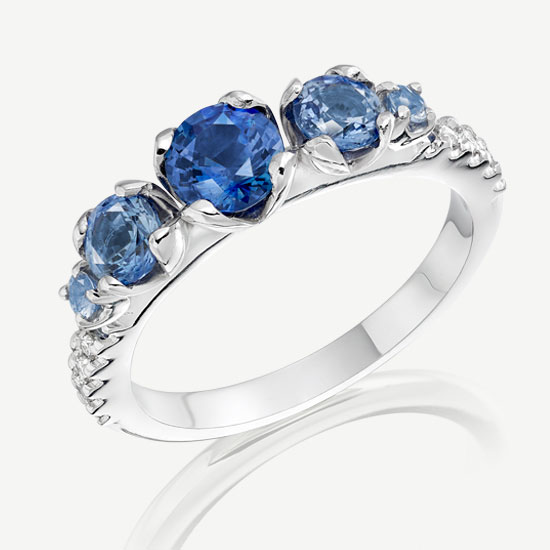
Considered to be an ancient symbol of honesty, loyalty and trust, sapphires make a unique and elegant choice of engagement ring and these rings are the precious gift for a loved one to cherish whatever the occasion.
Perfectly suited to more everyday wear, two additional new delicately crafted three stone rings also join the Lief Collection this autumn.
Beautiful hues of blue are the theme of the first which showcases stunning Aquamarine and Tanzanite, while a spectrum of soft pinks sparkle in the Winterson Lief Ring with Pink Tourmaline and Morganite.
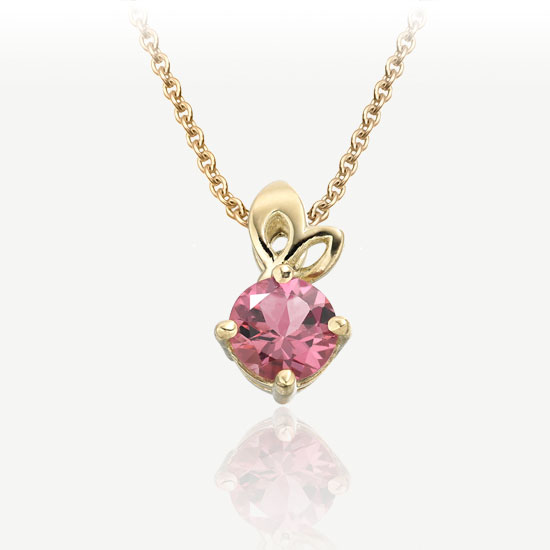
These gemstones are also the stars of the new Lief pendants, with a choice of sparkling Aquamarine or Pink Tourmaline set in place with two delicate flower leaves fashioned from 18 carat gold.
The Lief Collection offers elegant femininity amid the delicate colours of an alpine meadow. A perfect gift for someone special. Including you.
-
Introducing the Lief Collection to Winterson
Introducing the Lief Collection to Winterson
This week we are delighted to launch a new collection of jewellery called Lief, which is also the old English word for "Beloved".
The newly launched Lief collection has been designed by our new Creative Director Alice Cicolini, who first began working with Winterson in 2013.
ALICE CICOLINI
Alice is a successful jewellery designer, creative commissioner and producer, with her work currently being stocked at Net-A-Porter, Dover Street Market, Urban Flower Grange Hall and Colette.
Her first collaborative collection with us called ‘Beau’ - a flamboyantly British range of seed pearl jewellery – is available exclusively at Winterson.
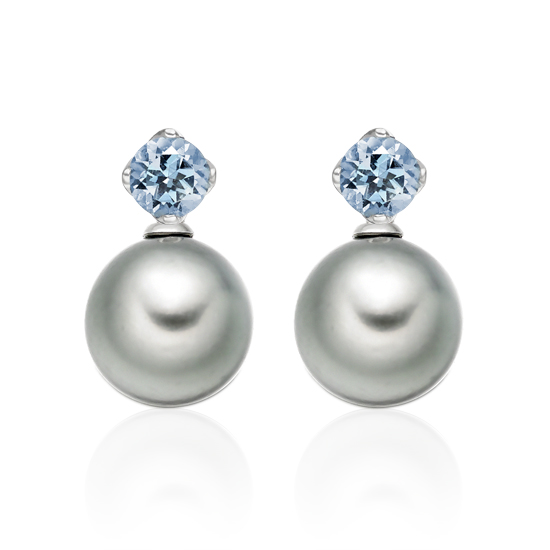
In her official Winterson role, Alice will be responsible for the creative conception and product development of the classic, bridal and fine jewellery collections at Winterson. She will also establish and manage our exclusive collaborations with other up and coming British designers.
Alice brings a distinctive style and influence to our jewellery that has already inspired our customers with her Beau collection, rings and earrings. We are delighted to welcome her fully to our team.
THE INSPIRATION FOR LIEF
The new Lief collection is based on the Winterson brand motif, which is inspired by a wild northern flower called Linnaea Borealis.

This little alpine twinflower is named Carl Linnaeus, a world renowned Swedish botanist who is also believed to have been the first to culture successfully a spherical cultured pearl.
Alice's designs for Lief are an exquisite fusion of colourful gemstones and diamonds with Winterson’s signature pearls. Clever interchangeable design allows the wearer to create different looks across the collection, from everyday to the more formal.
Three designs beautifully capture the essence of spring and colour and will be an exciting range of enduring classics to treasure.
LIEF, ENCHANTED AND ENTWINED

The new Enchanted Diamond Earrings sparkle with 36 ice clear gems and are finished in white and yellow gold. Stunning on their own, they can also be combined with a selection of our carefully chosen pearls, crafted with an 18 carat gold loop and expertly designed to fit the Lief stud earring earpost.
New elegantly understated studs also join the range with a beautiful selection of gemstones to tempt, from soft Morganite and Green Beryl, to vibrant Pink Tourmaline, Aquamarine and Amethyst. Each stud earring can be paired with white Akoya or Freshwater Drop pearls, naturally grey Tahitian pearls, or simply worn on their own.
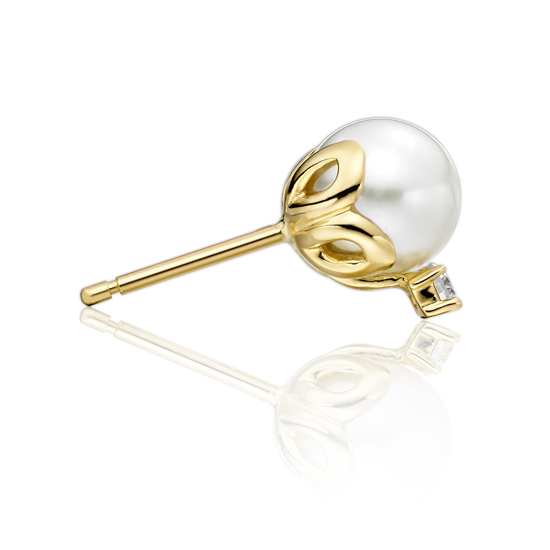
New Entwined Pearl Stud Earrings feature wild gold leaves, entwined around a pair of white Akoya pearls and adorned with two round white sparkling diamonds.
Discover the Lief collection here.
-
1920s Jewellery Style and Inspiration
1920s Jewellery Style and Inspiration
Modernism characterised the style of 1920s jewellery, inspiring design even today with its bold, geometric lines and forms.
Following the end of World War I, this decade saw increasingly prosperous times and technological advances. Most of the creative arts sought a break from the past and looked for new directions.
In fashion, it was the decade of the Roaring Twenties with working women wearing more comfortable and practical clothes with slim, streamlined designs. Jewellery was also no exception with a number of important changes and developments.
BAUHAUS AND ART DECO
In the 1920s jewellery broke away from the romantic and elaborate, natural forms and arabesque designs of the Art Nouveau movement of 1890-1910 (during the "Belle Epoque").
In this new decade, jewellery was stripped back bare to its geometric shapes.

Aesthetic clean lines were inspired by designs found in industrial machines. A key influence of this modernism was the influential Bauhaus movement, with its philosophy of form following function.
Contrasting textures and colour were also in fashion. Examples of changing tastes in design were the use of diamonds being set against onyx or translucid citrines and amethysts juxtaposed against opaque coral and jade.
COSTUME JEWELLERY
Fashion designer Coco Chanel broke away from real gemstones with cheaper glass products. The Maison Gripoix, which still exists today, was an early partner for Coco Chanel in creating a range of glass jewellery. The iconic long pearl rope necklace was a signature piece of faux jewellery created at the time.
Josephine Baker, pictured below at the Folies Bergères in Paris, was an icon for the new Art Deco movement, with her fearless style, slicked down hair and bold earrings, oversized rings and ropes of pearls.

Glass jewellery was still expensive and only became affordable in the 1930s with injection-plastic moulding techniques. But Coco Chanel, by stepping into the world of faux jewellery, in effect launched a future industry of costume jewellery.
MACHINE-CUT GEMSTONES
Until the 1920s, gemstones were hand-cut and hand-polished. With the latest developments in machinery, it also became possible to machine-cut and polish gemstones, generating sharp lines and edges, sparkling facets and complicated new gemstone cuts.
The rectangular baguette-cut became hugely popular around this time, as it complemented the geometric designs of the day.
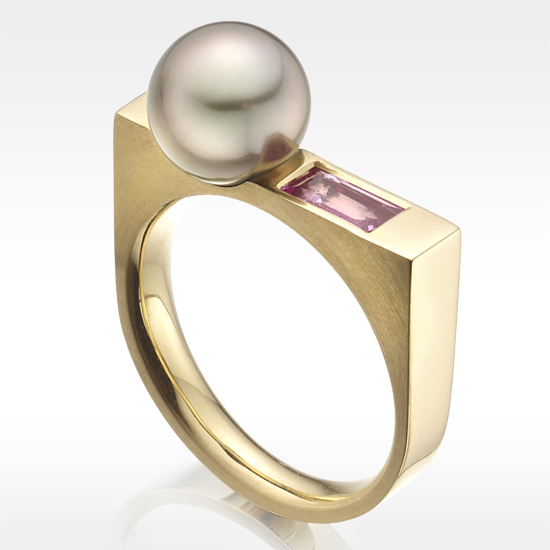
Jewellery of the 1920s then was an innovative period that would become notable for its stunning, daring design.
At Winterson our Luna Rose Tahitian Pearl Ring evokes the 1920s jewellery style of this creative period. The gold shank of the ring has a geometric, solid shape and an angular, baguette cut pink sapphire.
The unusual aubergine colour of its Tahitian pearl, however, would have been unknown in the 1920s and is perhaps entirely modern too.
-
A Guide to the 4Cs of Diamond Grading
A Guide to the 4Cs of Diamond Grading
One of the most precious gemstones, a sparkling diamond has been prized by jewellery lovers for almost as long as pearls. Their qualities could not be more different, however. Whereas a pearl has a complex, organic beauty, the distinctive diamond owes its name to the Greek word meaning 'unconquerable'. The diamond is one of the hardest gemstones that we know, allowing a skilled jeweller to cut and shape the stone to show off its unique relationship with light.
The 4C's system was developed by the Gemological Institute of America in the 1940s and 1950s to help explain the complexities of grading a diamond. The 4C's stand for Carat, Color or Colour, Clarity and Cut. The system is still used widely today. At Winterson, we also use the GIA's system to help explain how we grade pearl quality.
CARAT
A carat is the unit used to measure the weight of a diamond, with each metric carat weighing 0.2 grams. Carat weight is not the same type of carat as that used to describe the purity of gold, but takes its name from the carob seeds that were used as a balance on the scales of early gem traders. A carat may also be divided into 100 points, with 15 points representing 0.15 carats.
In jewellery, the greater the weight of a diamond, the greater its rarity and value. One of the largest diamonds ever found was the priceless Cullinan Diamond, weighing 3,105 metric carats.
COLOUR
The most popular diamonds used in fine jewellery are white to near colourless, representing their purity. The 4Cs scale grades these diamonds from D (Exceptional White+) to H (White), with colour and tints of yellow starting to occur at grades from I to Z. Diamond colours need to be examined in controlled lighting conditions, but in general the less colour that a diamond has, the higher its value.
CLARITY
As with other gemstones, a cut diamond may have a number of small internal blemishes or inclusions. These do not necessarily limit the beauty of a diamond and in many cases will not be visible to the naked eye.
- The very best clarity grade on the GIA grading scale is a remarkable flawless diamond graded F1 or 1F.
- Very very slightly inclusions are graded VVS1 and VVS2 and are difficult to see for a skilled grader even under a 10x magnification.
- The next grades of VS1 or VS2 have very slight inclusions, that may be visible under a 10x magnification, but are still used successfully in fine jewellery and can offer excellent value to a discerning buyer.
- The final grades of S1 and S2 and P1, P2 and P3 imperfections have inclusions that are easy to see under magnification or to the eye.
CUT
The final and most important grading factor gives a diamond its dazzling qualities. This grade is also one of the hardest to judge, being dependent on how much light is reflected by the diamond (brilliance), its sparkle when it is moved (scintillation) and how it disperses light into different colours (fire).
The traditional round brilliant cut has 58 facets, with an established geometry of angles and size, but many other shapes can be exquisitely used in a variety of jewellery designs and styles. Whatever the shape, the quality of the cut of a diamond may be graded as Excellent, Very Good, Good, Fair to Poor.
Discover more about why Diamonds (and Pearls) are forever.
-
Inside Out Gems and Jewellery at IJL 2012
Inside Out Gems and Jewellery at IJL 2012
A stunning kaleidoscope of colour, gems and jewellery awaited visitors to this year's International Jewellery London exhibition. As well as catching up with some of the new trends for the Winter season to come, one of the highlights of London's leading annual jewellery event is in finding some creative and innovative collections by new designers.
IJL's Bright Young Gems initiative is now in its 8th year and gives a selection of exciting new designers a unique opportunity to showcase their work. Previous winners include Sophie Breitmeyer, with whom we launched a collection of Akoya pearl earrings and pendants last Autumn.
Chosen by a leading panel of judges, the winners of the award this year included watch-maker Sophie E Ellis, an original and playful collection by Neil Marlow and Swarovski award scholar Stephanie Bila. Impressively, three of the four winners recently graduated in Jewellery Design from the renowned Central Saint Martins design school in London.
Perhaps the most eye-catching of all was Katie Jamieson's Hidden collection, a beautifully series of architectural rings, pendants and earrings inspired by the secret garden inside the Serpentine Gallery's 2011 Summer Pavilion. These polished silver earrings (pictured) create a sparkling riot of colour with their central gemstones of tsavorite garnet and tanzanite, being surrounded by pink rubies, orange sapphires, yellow diamonds and more tsavorite garnets. Other pieces hid their gems away, to be revealed only with a movement of the hand or by sound. Designed with surprises, Katie Jamieson's jewellery succeeds in creating a collection to explore.
Elsewhere in the show, traditional design mixed with the contemporary and it was a great chance to catch up with new pieces from some favourite and established designers. Andrew Geoghegan's vibrant Chocolate Box Ring, set with baguette cut gems of aquamarine, amethyst and citrine was a perfect way to finish off the colour theme.
-
Classic White Pearls and Black Onyx
Classic White Pearls and Black Onyx
Black onyx is the most popular form of onyx today, with a dark silky lustre that contrasts beautifully with the creamy whiteness of classic pearls.
Onyx is a variety of the chalcedony gemstone, which is a species of microcrystalline quartz that also includes different coloured Agates and Jasper. Found in bands that run parallel to each other, and mined mostly in the USA, Brazil, Madagascar, Uruguay and India, the colour of the chalcedony bands can range widely from reds, greens and blues to shades of white and grey. The red brown variety of onyx is known as sardonyx.
The onyx stone is slightly translucid, which perhaps inspired the Ancient Greeks to give it its name. Legend tells that Cupid cut the fingernails of Venus whilst she was sleeping and the discarded clippings were turned into stone by the gods. It is a relatively hard and durable stone, has a silky lustre and has been used and carved for centuries for setting in jewellery.
Black onyx itself is a deep rich black but, from ancient times and still today, this is mostly achieved through enhancement with heat and other colour treatments to achieve its stunning uniform dark colour.
Onyx jewellery can be very affordable and desirable, with an ability to match most colours or to highlight a sparkling white diamond and other brightly coloured gemstones such as a pink ruby. Black onyx can also work well with both yellow and white gold and is a favoured choice for elegant evening wear.
We love the contrast of how a lustrous white pearl can be flattered by the deep darkness of black onyx. The ‘black and white’ style created by the effect of combining onyx, pearls and diamonds has been widely used for jewellery design since the Art Deco 1920s and 1930s. Cartier, in particular, has worked with onyx since the 1910s and continues to choose this gem for its outstanding designs.
Onyx is a traditional gemstone for celebrating a 7th wedding anniversary.